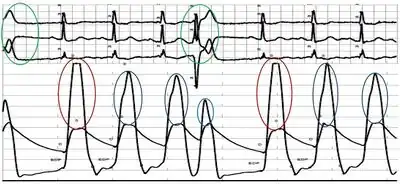Brockenbrough-Braunwald-Morrow sign
| Brockenbrough-Braunwald-Morrow sign | |
|---|---|
 | |
| Simultaneous measurement of left ventricular and aortic pressures after isoproterenol administration exhibiting evidence of 120 mm Hg gradient (blue oval at lower panel). An intensified left ventricular-aortic gradient (red oval at lower panel) is noted after premature ventricular contraction (green oval at upper panel). | |
The Brockenbrough-Braunwald-Morrow sign is a medical sign to detect left ventricular outlaw obstruction in obstructive hypertrophic cardiomyopathy (HCM).[1]
It is carried out by cardiac catheterisation and characterised by an increase in left ventricular gradient following a provoked premature ventricular contraction (PVC).[2] In HCM there is typically a decrease in arterial pulse pressure after a PVC (unlike in aortic stenosis), accompanied by a significant rise in peak LV systolic pressure.[1] It is calculated by subtracting the aortic pressure from the simultaneous left ventricular pressure.[2] It is also used to assess the effectiveness of septal myectomy and alcohol septal ablation; treatments for HCM.[1]
It was first described in the 1960s by Eugene Braunwald, Andrew G. Morrow and colleagues.[1][3]
References
- 1 2 3 4 Cui, Hao; Nguyen, Anita; Schaff, Hartzell V. (October 2018). "The Brockenbrough-Braunwald-Morrow sign". The Journal of Thoracic and Cardiovascular Surgery. 156 (4): 1614–1615. doi:10.1016/j.jtcvs.2018.04.095. PMID 29884502.
- 1 2 Cui, Hao; Schaff, Hartzell V. (2020). "80. Hypertrophic cardiomyopathy". In Raja, Shahzad G. (ed.). Cardiac Surgery: A Complete Guide. Switzerland: Springer. pp. 735–748. ISBN 978-3-030-24176-6. Archived from the original on 2023-01-10. Retrieved 2023-05-28.
- ↑ Trevino, Alejandro R.; Buergler, John (1 January 2014). "The Brockenbrough – Braunwald – Morrow Sign". Methodist DeBakey Cardiovascular Journal. 10 (1): 34. doi:10.14797/mdcj-10-1-34. ISSN 1947-6108. Archived from the original on 30 October 2022. Retrieved 30 October 2022.